
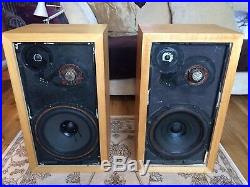


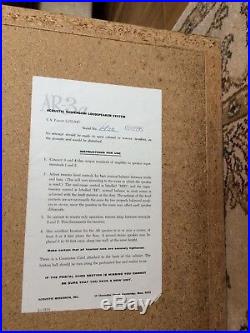
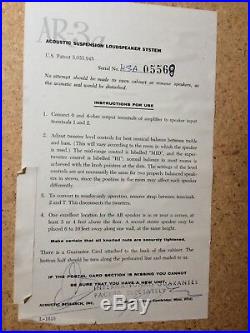

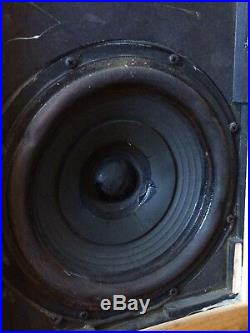


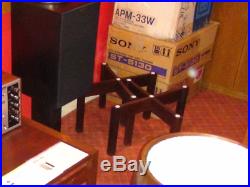
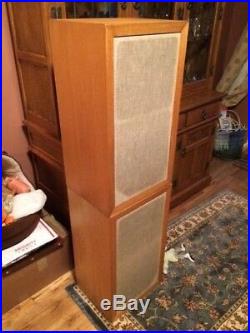

Unseen rare model in the UK , all original made in USA , only on set is for sale the other model is AR-3a Improved you can see the difference between the two models. Original AR stands , dark brown. Ive been looking for this model for ages till got this incredible pair kept by a music lover in pristine. The drivers are early models and one woofer has the original cloth surround, never touched. Beautiful cabinets in fantastic condition, pine light suave rare colour for this model. The price reflects the quality of these speakers considered by audiophiles as one of the Best Speakers of all times. Taken from Google web. Edgar Villchur and Acoustic research. Villchur earned his Masters in Education degree at The City College of New York and was a writer and teacher at NYU in 1954 when he discovered a new design for loudspeakers. Specifications of 1925, dynamic speakers had become large and boxy in order to reproduce low frequencies. A bass speaker capable of a 40 Hz tone was very large, more suitable for motion picture theaters than for home phonograph systems. The hi-fi market was starting to expand in the early 1950s, with new sensitive pickups and amplifiers capable of reproducing the full dynamic range of the new LP record. But speaker designers were still struggling with the problem of extended, low-distortion bass. Villchur decided to try a radical new approach: Instead of making one more attempt to unravel the Gordian knot, I cut it. I used a different kind of elastic restoring force, one derived from an air spring, instead of the mechanical springs of the suspensions. This turned out to be not too difficult – after all, the speaker has a cabinet which encloses a cushion of elastic air. All I needed to do was to decimate the springy stiffness of the speaker suspensions, and reduce the size of the enclosure until the air spring was strong enough to replace the mechanical springs that we threw away. It also turned out that within the compressions and rarefactions that this air spring would undergo, the response was almost perfectly linear. Thus, the acoustic suspension loudspeaker is an obvious and simple system. You are merely substituting an essentially linear air spring for a nonlinear set of mechanical springs. Villchur used two standard 12-inch Western Electric loudspeakers in designing his new enclosure. I cut away part of the spider of one of them, making it more compliant. I also cut away the entire rim suspension and replaced it with a suspension made of mattress cover material (bacause it is very compliant, and adequately impervious to air). My wife, Rosemary, had worked as a draftsperson during WWII. With those skills, she was able to project my sketch of the three dimensional suspension to the correct pattern on the mattress material so that I could cut it out and form it to the shape I needed. I mounted the second Western Electric speaker on a baffle at the head of an enclosed stairway, so I could compare the performance of my acoustic suspension system with an enclosure volume of two cubic feet against and infinite baffle system with well over 100 cubic feet. The acoustic suspension system was substantially superior in fulness of bass, and especially in lack of distortion. Villchur took his new design to two speak manufacturers but they were not interested. One of his former students, Henry Kloss, was interested. “After these two rebuffs, and in particular the nature of the rebuffs, I changed my mind, ” said Villchur. In the spring of 1954, Villchur drove Kloss up to his lab in Woodstock, describing the theory of his new design along the way. After they arrived, Villchur played some recordings, including an E. Power Biggs LP with copious low-frequency content. After hearing it, Kloss exclaimed, That’s it! And offered the use of his Cambridge loft to manufacture acoustic suspension loudspeakers. “And thus, AR was born, ” observed Villchur. Since they didn’t have the capitalization to hire a production engineer to convert the prototype into a production model, Kloss worked out the details. Henry was responsible for at least 75 percent of the production design of the AR-1. The rest was done by me and by Tony Hoffman, a physicist friend of Henry. They assembled several AR-1 loudspeakers in time for the New York Audio Show in September 1954. Although the critics were impressed with the clean 32-Hz organ pedal tones that the AR-1 could reproduce, they did not quite get the point. One critic commented,’ If your space is limited and you’re looking for a small speaker, you should consider the AR-1 very seriously. It’s a fine speaker – for its size. Julian Hirsch, who at the time published the Audio League Report, wrote that’the AR-1 had the lowest electroacoustic efficiency of any loudspeaker on the market – but at 25 Hz and below, it was more efficient that the Klipschorn, which had the highest efficiency of any speaker on the market. Hirsch also said that the AR-1’established a new industry standard for low distortion bass. Eventually, the industry began to realize that the smaller size of the cabinet was only a secondary advantage of the extended bass response. The acoustic suspension speaker of Edgar Villchur has been considered one of the five most important speaker designs since the Rice-Kellog dynamic speaker of 1925. What really caught the public fancy, however, was the fact that the original Acoustic Research AR-1 was a small loudspeaker system having essentially flat low-frequency response to- below the 40-Hz region. Other manufacturers were quick to point out that the AR-1 gobbled up about 10 times the electrical power needed by larger, more efficient systems. With 50- and 60-watt amplifiers becoming available, this turned out not to be a major drawback, and the trend toward smaller, less-efficient home loudspeaker systems was firmly established. The use of this small inexpensive speaker by such notables as Louis Armstrong was featured in AR’s advertising. By 1958, Villchur added a new tweeter to the AR-3. The dome tweeter was Villchur’s answer to the problems of high frequency dispersion. When you are listening to a loudspeaker in a normally reverberant room, and that loudspeaker has excellent on-axis high-frequency response but depressed off-axis response, the loudspeaker will sound dull in any listening position in the room, including one directly on-axis, because the major part of the sound you hear is that reflected from the walls, floor and ceiling. Putting a dispersing lens in front of the driver doesn’t help much because there isn’t enough high-frequency energy to disperse. The secret of high-frequency dispersion can be stated in two words: small size. Shrinking a cone tweeter to a small size doesn’t help because the voice coil becomes too small to handle any appreciable amount of power. I placed my voice coil at the large diameter of the diaphragm. When you do that, the shape of the diaphragm emerges almost naturally as a dome. That has the further advantage of making unnecessary a second suspension, and it also greatly facilitates solution of the other problems (irregular frequency response and response at the extreme high frequencies). Some years later, Roy Allison improved the dome tweeter by making one with a pulsating motion. Villchur himself wrote most of the advertising copy and brochures for the company in the 1950s and 1960s, emphasizing facts and performance. This style of the 1960s ads. Continued in the 1970s ads. Villchur sponsored live vs. Recorded concerts to demonstrate the accuracy and low distortion of his speakers. He placed the musicians (the Fine Arts String Quartet, among others) on the stage, with a pair of AR-3 loudspeakers behind them. At various points, they would stop playing and the taped performance would take over. Most reviewers of the day could not tell the difference between the live and recorded sound. I thought these concerts defined what we meant by high fidelity,’ commented Villchur. He took care to use the best equipment possible at the time, including an Ampex tape deck, two 60-watt Dynakit amplifiers, and number18. Villchur left AR in 1967 to establish the Foundation for Hearing Aid Research where he developed hearing aids with a system combining compression and equalization that were manufactured by the Resound Corporation. He was appointed a Visiting Scientist at the Massachusetts Institute of Technology and would write numerous articles and books on acoustics that would be published by professional journals of the ASA, IEEE and AES and reprinted by university presses. He continues to live and work at his Foundation in Woodstock NY. “Theory, Ingenuity, and Wizadry in Speaker Design, ” Audio, April 1987 p. 51-55, originally published in Journal of the Acoustical Society of America 77, No. 4, April 1985, p. “Acoustic Suspension, ” Journal of the Audio Engineering Society 41, November 1993, p. The item “AR-3a Acoustic Research speakers 100With4 ohms Blonde Birch 1969 unique AR stands” is in sale since Wednesday, April 24, 2019. This item is in the category “Sound & Vision\Home Audio & HiFi Separates\Speakers & Subwoofers”. The seller is “6656max” and is located in BOREHAMWOOD. This item can be shipped worldwide.
- Model: AR-3a
- Colour: Pine
- Country/Region of Manufacture: United States
- Sound Quality: High Fidelity (Hi-Fi)
- Connectivity: Wired
- Features: 4ohms !
- RMS Power: 100w
- Speaker Design: 3-way
- Brand: Acoustic Research
